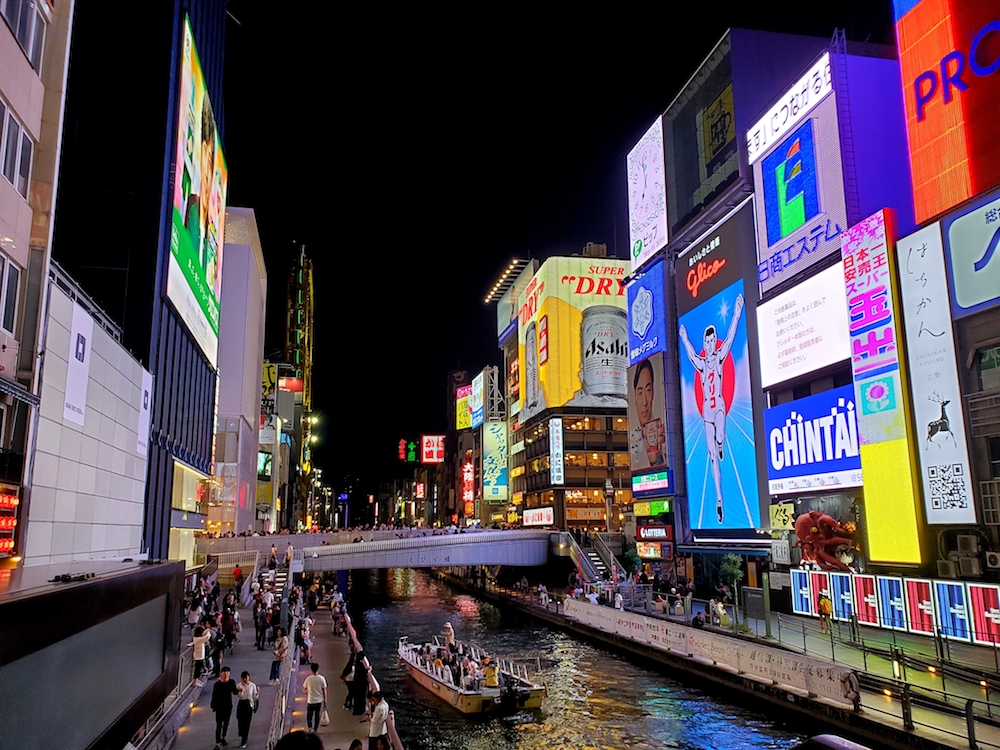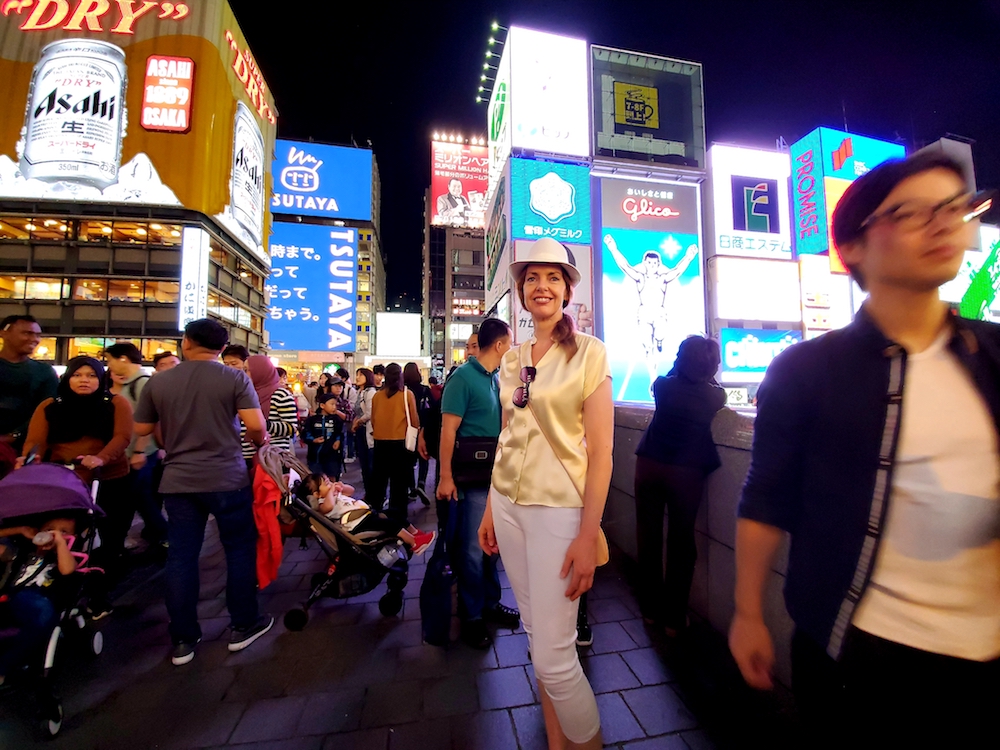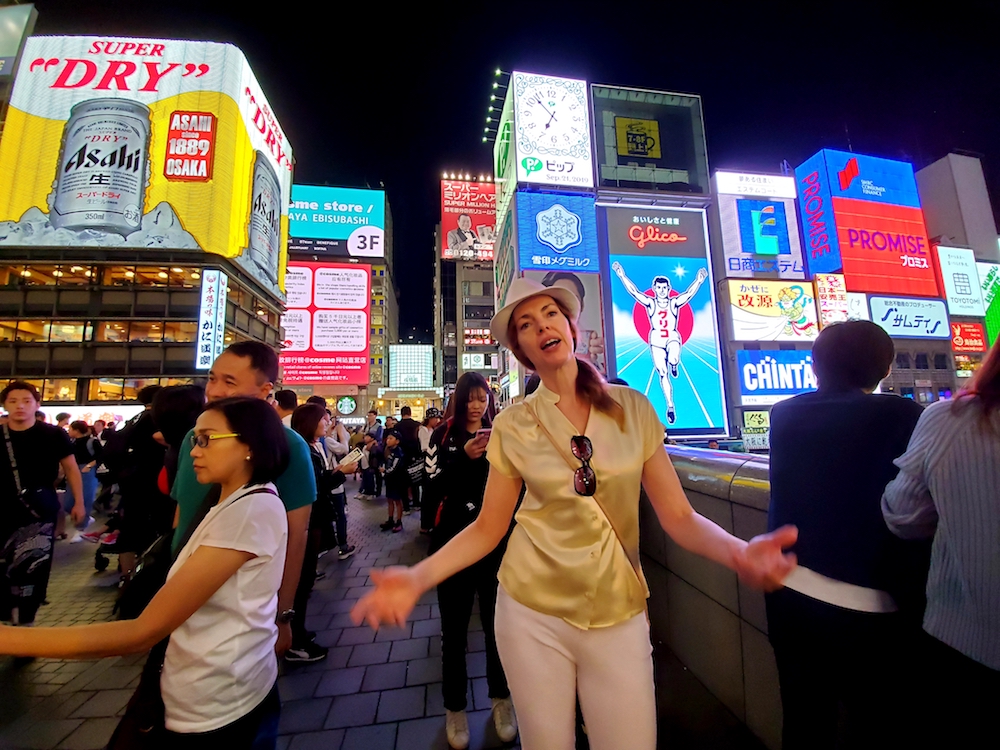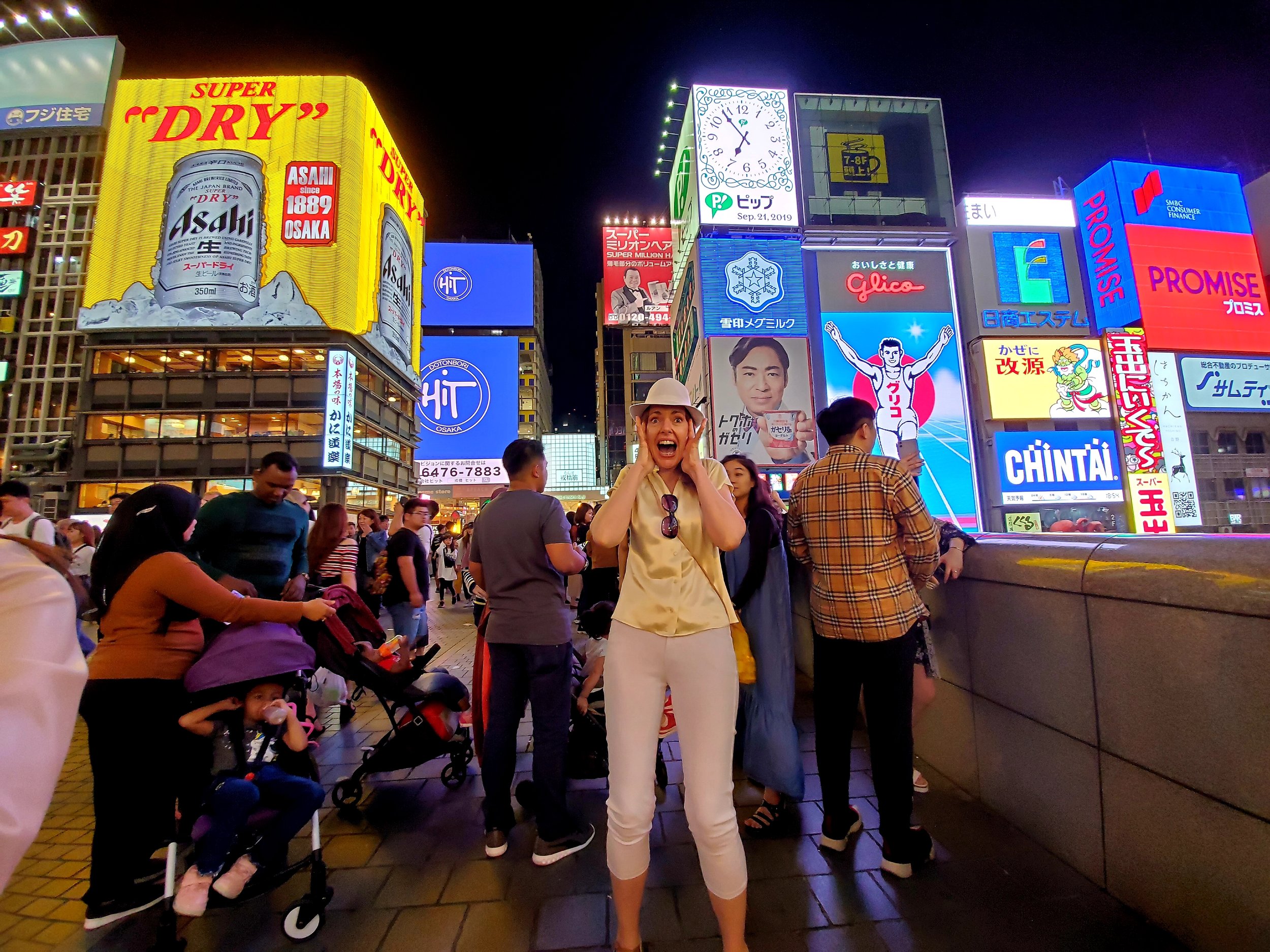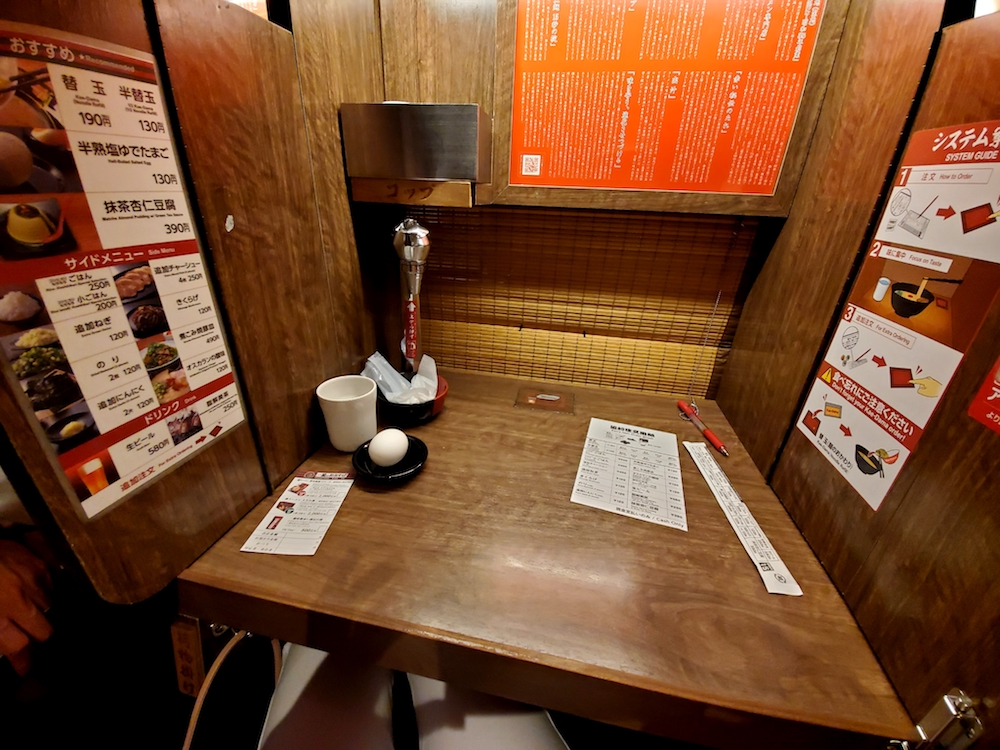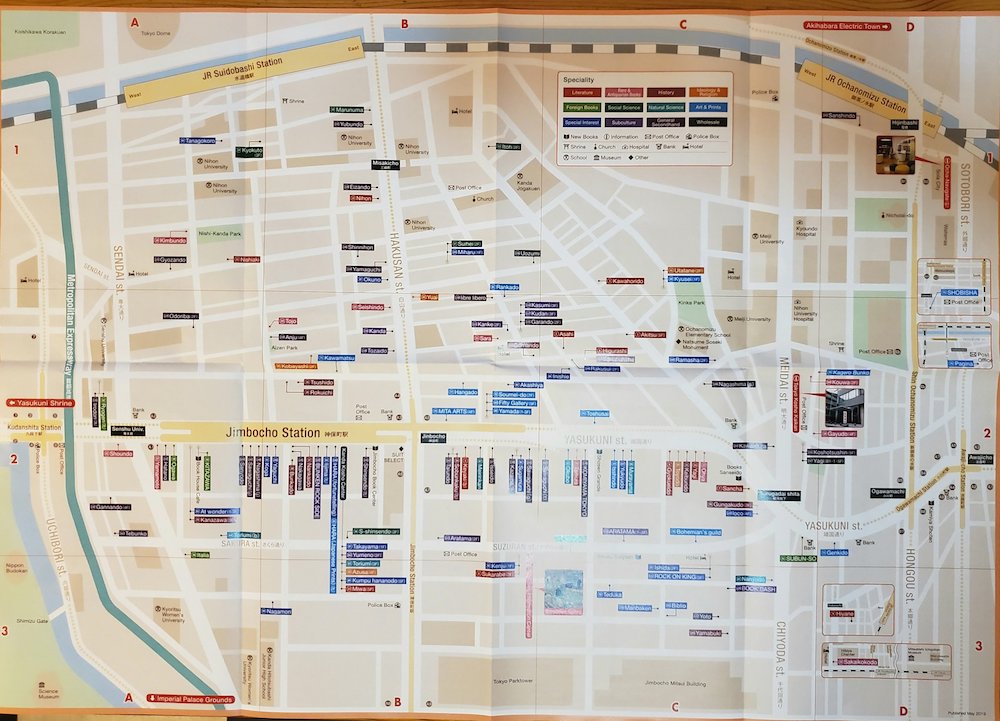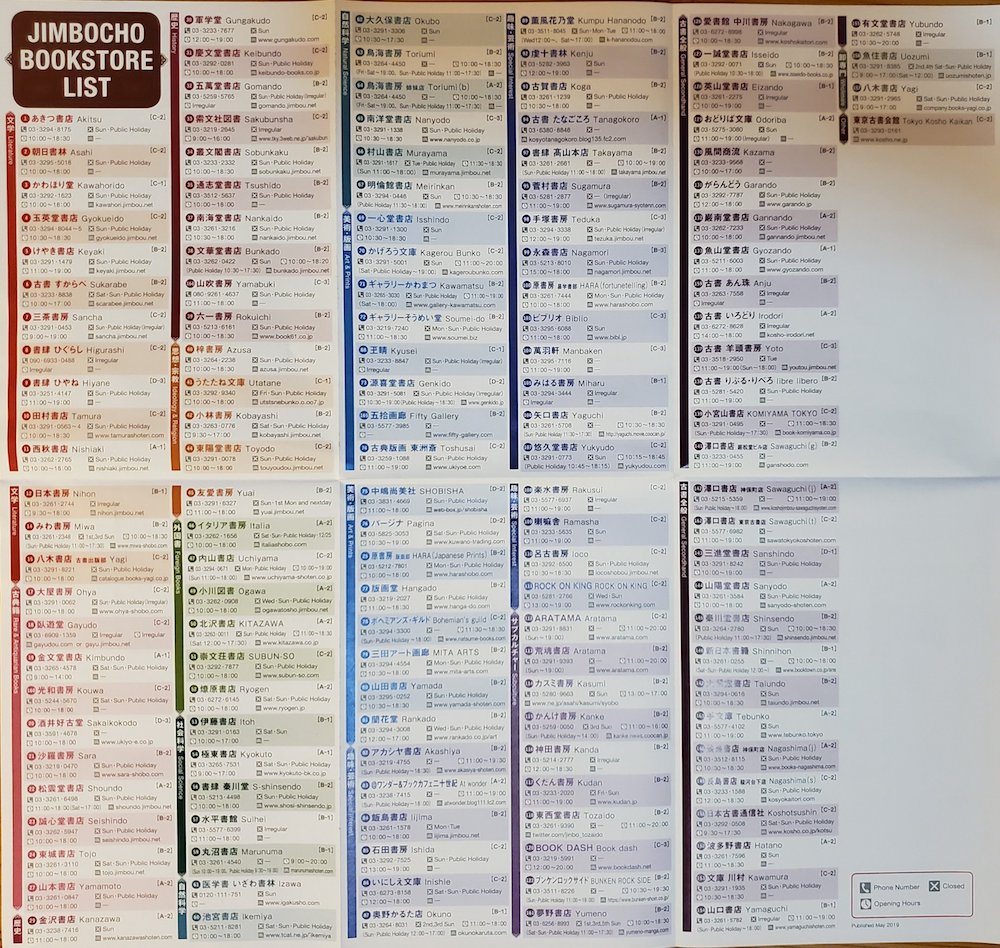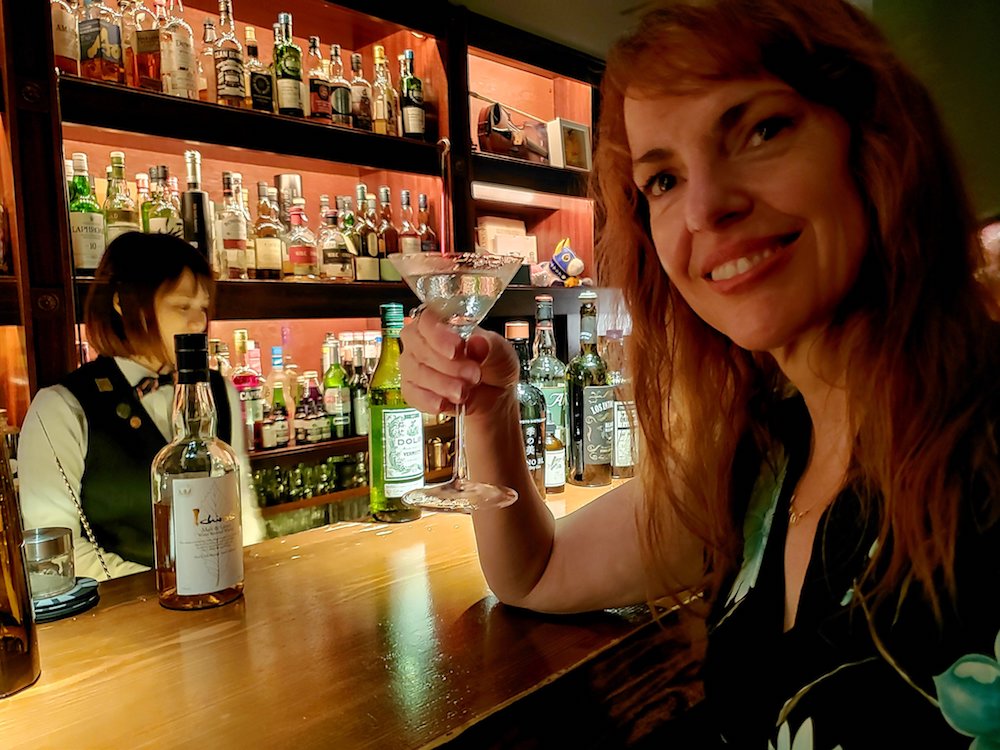In Osaka, we check in to another Toyoko Inn near the train station, which is a suburban neighborhood, grab a bite to eat, and hit the sack early.
Selena at the Takauchi Coffee Shop in Osaka.
The next morning it is overcast and we walk the empty streets to the closest cafe, called Takauchi Coffee Shop. What character it has! Small, indie place run by an older gent in spectacles, dress shirt and tie who takes great pride in running his cafe. There’s kind of intense classical music playing, the walls are crowded with shelves of vinyl records, CDs, books, magazines, plus a shelf of old and new teapots and cups, and various antiquey-looking knickknacks fill up the rest of the available space. In the dim, warm lamp light, I gaze out the window into the gray morning and wonder if the bicycle with the basket leaning against the cafe is the owner’s. I feel like I am in an indie film.
R and I have coffee in quaint teacups and saucers with silver cream and sugar containers and “Tōsuto soshite jamu” (toast and jam) on thick-cut, homemade wheat bread. Delicious!
We take the train to Osaka Castle, a large and ominous building (made less so, however, by the gazillion tourists swarming it). Much like the Eiffel Tower or Empire State Building, it has been corporate-ized: line up to buy ticket, line up to enter, follow arrows that point the way, line up for elevator, etc. Somehow I don’t think that 16th-century samurai Toyotomi Hideyoshi had a gift shop in mind when he built this moat-encircled fortress.
Osaka Castle.
Richard & Selena at Osaka Castle.
At the top of the castle, there is chicken wire around the balcony to prevent falling or jumping — or taking a good photo of the city below. So we check this place off our list and move on.
We take the train to Dōtonbori, a “lively entertainment district known for its soaring illuminated billboards, restaurants and theaters.” Jesus, that’s putting it mildly! It’s like Vegas or Times Square on crack!
Dōtonbori, a “lively entertainment district” in Osaka.
The canal/river in Dōtonbori, Osaka.
Holy crap, it’s like people stew! And who knew that there were “canals” (the Dōtonbori River) in Osaka?
Here’s a sequence of pictures of me quickly becoming totally overwhelmed in this crowd:
We hit Ichiran, a ramen bar — or what R calls an “eat and fuck off place” — in which you order your customized ramen, go up one flight of stairs to the eating floor, a long narrow space with individual “study cubicles”, and then your food is pushed out from behind a bamboo curtain where you only see the hands and waist/hips area of the mysterious server.
Ichiran, the “eat and fuck off” ramen bar.
Richard & Selena at individual eating cubicles at Ichiran ramen bar.
Each cubicle has its own water tap (like on-tap beer), cup and chopsticks. Napkin dispenser and toothpick dispenser are mounted to the communal wall behind you at 5-6 foot intervals. Need more of something? Fill out the form that’s right there, press the button beside it, slide the form forward towards the body-less hands, and ta-da! When you’re done, you exit out a different door from which you entered. This experience was awesome (especially if you’re not in the mood to be social) and the food was delicious.
Note the straightforward “system guide” below — I particularly like #2: “Focus on taste.”
Ichiran ramen bar “system guide.”
Delicious ramen at Ichiran.
After eating, we walk around and take a load off our feet at the Brooklyn Parlor, a New York-style cafe with sofas, candlelit tables, bookshelves, brick walls and live music (sometimes) or canned electronic/Top 40 music (usually). They serve coffee, alcohol and some food. Great atmosphere!
Sidebar: A warning alert for Typhoon Tapah (No. 17) pops up on Google Maps. Fortunately for us, its center is in the East China Sea and the Sea of Japan to the west of Japan and the direction is headed north, but unfortunately, its effects hit Saga in SW Japan where R’s wife and her family are. Needless to say, we are worried and R stays in close contact with her.
Just days before I arrived, Typhoon No. 16 hit Tokyo where R and his wife were staying. It was scary, but they were fine, and by the time I got there, the city had repaired and cleaned up the mess thanks to a sound infrastructure. Because of global warming, Japan has already had 17 typhoons this year (and it’s only September), instead of the usual 5 or so.
The next morning, I pack up all my shit again. I normally stay in one place when I travel, so I’m unused to the constant tiring-slash-adventurous packing and unpacking, and I’m this close to tossing half my belongings out the window. We walk along deserted streets in the windy, cloudy morning to JR Station, pulling our rolly suitcases with one hand and holding our phones with the map open in the other. The WiFi on each of our phones alternately goes out, so we tag team the navigation.
In lieu of breakfast, I get a GTL at the Starbucks in the station and realize that instead of asking you for your name, which is considered rude in Japanese culture, they give you a receipt with a number on it which you present at the quiet pick-up counter.
By the way, every public bathroom has a panel like this next to the toilet. Note the “privacy” option (plays music and nature sounds). Also, is “wand sanitizing” some kind of euphemism…?
Typical toilet panel of buttons.
This is more common in private homes, so I’m told, but in one temple we visit where you remove your shoes upon entering, they provide “toilet slippers” for the bathroom. In the U.S. you can’t even get men to wash their hands taking a leak, never mind wearing special shoes so as to keep bathroom germs in the bathroom.
Tokyo
On the bullet train bound for Tokyo, tiredness starts to creep up on us and we settle into a comfortable silence. That’s another thing I love about R — as a co-introvert, he is not afraid of silence between friends.
Head leaned back (in these ultra comfortable train seats!), I stare out the window at the passing scenery and realize that a small mountain half concealed in low-hanging clouds is Mt. Fuji. I take a picture and some video, but it looks nothing like the “active volcano,” “country’s tallest peak” or “iconic profile” for which it is famous. Also, I am disturbed that it has received 4.5 out of 5 stars on Google. Who reviews Earth??
We check in to another Toyoko Inn, this one in Ikebukuro (a district in Toshima, which is one of 23 wards in Tokyo), and meet up with an old friend of R’s (whom I met in Vancouver years ago) for lunch and a fun catch-up.
In the evening, I head out for a “get to know the ‘hood” stroll, the kind I can only do on my own, undistracted by another person’s chatter and unaffected by their opinions or interests. This has nothing to do with R, and as a matter of fact, he is the perfect traveling companion: independent, aware of others, on time, organized, spontaneous, thoughtful, fun, likes the same things the same amount as I do. But I never really seem to fully absorb a place or experience until I’m on my own.
It’s dark and raining and all the neon lights of the city are reflected on the wet pavement. A man stops me to ask me something, but all I can say is “Sumimasen, wakarimasen” (Sorry, I don’t understand). He smiles and continues on.
An hour later, R texts that he’s found another old-school coffee shop, full of character, and I head over in the wind and rain, my umbrella being pulled this way and that. When I arrive there, my hair is frizzed out from the mugginess, perspiration is dripping down my back from the summer-like temperature, and my feet are soaking wet.
The place is called Kohitei and it is on a small alleyway type of road. It looks like a bar — dark wood, dim lighting, a counter/bar, black-and-white-attired waiters — but it’s a coffee shop.
Kohitei coffee shop in Ikebukuro, Tokyo.
Over R’s shoulder I watch an older(ish) man at the counter reading a paper and sipping coffee pull out a pipe and light up like he’s on his front porch.
Kohitei coffee shop in Ikebukuro, Tokyo.
Fantastic character at Kohitei coffee shop in Ikebukuro, Tokyo.
The next day, R and I take the train to Ginza, a district of Chūō, Tokyo and a popular, upscale shopping area. It’s sunny, cloudy, humid and windy as hell, due to the typhoon. I see an older woman bent 45 degrees against the wind trying to cross the street. I’d help her, but the wind is pushing me down the street the other way.
I stop and stare at something I’ve never seen before: a “free WiFi” booth that looks like a (now ancient) telephone booth.
Free WiFi booth in Ginza, Tokyo.
We stop at Ueshima Coffee, the same one I saw earlier with the motto “precious coffee moments,” and I have milk tea (“made by thoroughly boiling a lot of tea leaves and combining it with milk”) and manju (bean paste inside a mochi ball).
Ueshima Coffee in Ginza, Tokyo.
I look at Google Maps to ascertain exactly where we are, and I notice that not only are cities and shops in Japanese, but now it’s giving me kilometers and meters instead of miles and yards! And yet this same machine learning technology won’t stop autocorrecting “and” to “asb” when I’m texting.
Due to a holiday — National Autumnal Equinox Observance Day (seriously, banks and post offices are closed, and bars shut down early) — the streets are dead.
Downtown Ginza on a holiday.
We browse a 12-story (twelve!) stationery store called Itoya, with such floors as “Share” (letter-writing paper, cards, pens), “Schedule,” “Travel,” “Fine Paper,” “Handshake Lounge” (conference rooms you can book) and “Farm” (indoor greenhouse a la The Martian).
The “Farm” level in Itoya Stationery store!
And then, and then….
We go to Ippodo Tea Store, a matcha crack house. It’s a traditional cafe and tea store — and work of art — and I feel my heartbeat pick up.
Ippodo Tea Store in Ginza, Tokyo.
We ask to be seated in the back at the counter, rather than at the tables closer to the front where everyone else is, because this way we are within drooling distance of the matcha masters (note glassy-eyed expression on my face below). We order the two highest-end (the richest and the most expensive) matchas: Ummon-no-mukashi and Shoin-no-mukashi.
Richard at Ippodo Tea Store in Ginza, Tokyo.
Selena salivating at Ippodo while waiting for matcha tea.
We watch the master prepare it in much the same way as at the tea ceremony we attended in Kyoto, and order some sweets to go with it (two kinds of mochi which we cut in half and share), thanks to the advice of Shogo (from the tea ceremony). Oh. My. God. The tea is absolutely delicious (rich, thick, earthy) and the whole experience is heavenly!
Tea master preparing matcha at Ippodo Tea Store in Ginza, Tokyo.
Green cocaine - i.e. matcha - at Ippodo Tea Store in Ginza, Tokyo.
We walk out of there on cloud nine (and a canister of the high-end matcha powder in my bag), and a couple blocks later we are in the Imperial Palace park grounds. Most of the park is public but sprinkled with police officers, including one who is stationed across the moat from a gardener who is trimming the palace-side moat hedge. “Don’t even think about scaling that 100-degree incline palace wall,” his stare seems to say.
Imperial Palace’s back door.
Imperial Palace moat.
Our stroll through the park takes us to the National Theatre where we have tickets for a Bunraku — a form of traditional Japanese puppet theatre — performance. (If you’re interested, check out this introduction to Bunraku.)
The performance is Musume Kagekiyo Yashima Nikki (The Blind Kagekiyo in Exile Meets His Daughter), which is interesting but a little too long at 4 hours, especially because I’ve forgotten my glasses. For the second part, R loans me his specs, and I feel like we are the blind kagekiyos.
Needless to say, after a half-workday-long performance of puppets I can’t quite see narrated by a chanter who bellows in a very “versatile” voice with an “extremely large range," we are ready for a drink. We hit another one on R’s bar bucket list: Bar Sherlock.
Richard & Selena at Bar Sherlock, in Ginza, Tokyo.
It’s on a narrow alley/road in what looks like a regular business building on the fourth floor with a door that looks like it belongs to a house (you can see it behind us in this pic)!
Once again, this small place has dark wood, cozy lighting, and attentive bartenders in black and white. The bar seats only about 6 and there are two small tables. Our bartender is young, cute and friendly, but it’s a little hard to flirt when you need a translator. Still, we all chat amiably while sipping delicious single malt Scotch “strātu” (neat).
Yamazaki single malt and Yoichi single malt at Bar Sherlock in Ginza, Tokyo.
A delicious Yoichi single malt at Bar Sherlock in Ginza, Tokyo.
The next day we take the subway to Kanda Jinbocho — i.e. “Book Town” — in Chiyoda City in Tokyo. There are about 140 bookstores here!! In fact, most of them provide a bookstore map, color coordinated by specialty (literature, foreign, second-hand, history, wholesale, etc.).
Click or tap the right/left arrow to see the back of the map:
R points out Isseido, the bookstore in front of which I posed in 2008 when we and some other friends came here, so we take a photo of me in the same pose (I added the same crappy blur effect just for comparison).
Selena at Isseido in 2008.
Selena at Isseido in 2019.
It’s our last chance for a great, Japanese old-school bar, so we hit up Bar Algernon in Ginza (another on R’s bucket list), which is “a bar that adds color and peace to Akasaka”. Damn right! It’s woman-owned (her name is Erika Oguri and that’s her in the background). She bartends, too — and makes a great cocktail!
Selena enjoying a cocktail at Bar Algernon in Ginza, Tokyo.
I wake up this morning feeling sad because in 7 hours I will be on a plane back to Los Angeles. Back to my regular life where no one takes the subway and if they do, they sure as hell don’t line up in a calm and orderly fashion. Back to coffee shops where dog-loving yahoos bring their yapping pets inside while they talk in outdoor voices on their phones. Back to ginormous portions of food served by waitstaff who’d rather be elsewhere.
I check out of the hotel (R is staying on to join his wife in Saga) and we put my luggage in a coin locker at Shinigawa Station and take the train to Naka-Meguro. We have lunch and then go to one of R’s favorite coffee shops called Onibus, a (you guessed it) shack-sized establishment with excellent coffee. From their website: “Onibus is a Portuguese word with the words ‘public bus’ and ‘for everyone’. Everyday life connecting people from bus stop to bus stop. I named Onibus Coffee with the idea of connecting people like a bus.”
We take our cups to the upstairs seating area with about two grade-school-sized tables and a thin counter that brings us eye to eye with the train tracks — and every five minutes or so a train roars by and shakes the whole place.
In Japan, it is customary to bring a little gift for your host when you visit their home, so I give R a thank you present and a heartfelt card that rambles on about how this incredible adventure could not have been possible without him and how fun it was traveling with him and how much I treasure his friendship. The gift is a coffee table book called Literary Starbucks: Fresh-Brewed, Half-Caf, No-Whip Bookish Humor that imagines “which intricate, elaborately named drinks might be consumed if your favorite authors and characters wandered into a Starbucks?” Coffee and literature — it’s perfect for him.
We return to Shinigawa Station to pick up my suitcase and then it is time to go. I’m sad to say goodbye to Richard, sad to leave this country, sad for my adventure to end. We hug and I walk through the gate to the train platform for Haneda Airport and try not to cry while playing human monopoly in the excellently formed line up.
Note: all photos taken by Selena Templeton or Richard Ii, unless otherwise noted.







